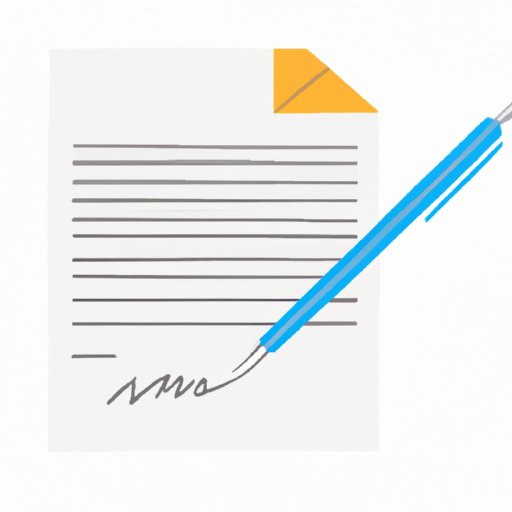
Introduction
Is writing a letter a daunting task for you? Do you find it difficult to know where to start or how to structure your letter? This article aims to provide a helpful guide on how to write a professional letter that will impress any recipient. Writing a letter is an essential part of business and personal communication. Knowing how to write a professional letter will help you to convey your message clearly and effectively. This article will take you through the step by step process of writing a professional letter.
Importance of Knowing How to Write a Professional Letter
Having the ability to write a professional letter is an important skill in both personal and professional life. It is an essential part of communication that helps you, as the writer, convey your thoughts and ideas effectively. A professional letter can also help to create a lasting impression on the recipient, and can even impact your professional reputation. Knowing how to structure your letter, use the appropriate tone, and emphasize the right points can make the difference between a successful and unsuccessful outcome.
Pre-Writing Stage
The pre-writing stage is the most critical stage when it comes to writing a letter. This stage involves planning and organizing your letter before beginning the actual writing process. Here are some points to consider:
Determine the Purpose and Audience of the Letter
Before beginning your letter, have a clear understanding of why you are writing it and who you are writing it to. Understanding the purpose and audience of your letter will help you to tailor your content and tone to suit the recipient.
Gather Necessary Information
Make sure you have all the necessary information you need before starting to write your letter. This includes names, addresses, dates, etc. Having all this information on hand can help you to write a more accurate and cohesive letter.
Plan the Structure of the Letter
The structure of your letter is important as it determines the flow of your content. Plan the structure of your letter by outlining the main points and organizing them in a logical order.
Writing Stage
Now that you have planned and organized your letter, it’s time to start writing. The writing stage involves four main sections:
Write the Salutation and Opening Sentence
The salutation is the greeting at the beginning of your letter. This can vary depending on who you are writing to and the level of formality required. Examples include “Dear Sir/Madam,” “Dear Mr./Ms.,” or “To Whom It May Concern.” After the salutation, craft a strong opening sentence that clearly and concisely states the purpose of your letter.
Write the Body of the Letter
The body of your letter should provide the main content and detail the purpose of your letter. Use clear and concise language that is easy to understand. Use short paragraphs and headings to break up large chunks of text. Make sure to emphasize your key points. If applicable, include supporting documents or statements in your letter.
Write the Closing Sentence and Complimentary Close
The closing sentence should summarize the content of your letter and provide a clear call to action. The complimentary close is a polite phrase that goes before your signature. Examples include “Sincerely,” “Yours truly,” or “Best regards.”
Sign the Letter
After you have written the complimentary close, sign your name below it. This adds a personal touch to your letter and makes it more professional.
Post-Writing Stage
The post-writing stage involves finalizing your letter and making sure it is ready to send. Here are some points to consider:
Proofread the Letter for Errors
Proofread your letter several times for spelling, grammar, and punctuation errors. Ensure that all names and dates are correct, and sentences make sense.
Edit the Letter for Clarity and Conciseness
Make sure that your letter is clear and concise. Remove any unnecessary language that does not add value to your letter. Make sure that your sentences are easy to understand and that your message is conveyed clearly.
Format the Letter Properly
Make sure your letter is formatted correctly. Use a standard font, spacing, and margins. Ensure that the letter is aligned properly, and headings are bold and clear.
Print or Send the Letter
If you are sending a physical copy, print your letter on quality paper. If you are sending an electronic copy, save your letter as a PDF and make sure to attach any supporting documents. Ensure that you have the correct mailing address or email address of the recipient.
Common Types of Professional Letters
Professional letters come in many forms, and knowing how to structure each type appropriately is essential. Here are some common types of professional letters:
Cover Letter for Job Applications
Your cover letter should introduce you to the potential employer, highlight your skills, and explain why you are the best candidate for the job.
Thank-you Note after an Interview
A thank-you note is a good way to express gratitude and demonstrate your professionalism after a job interview.
Complaint Letter to a Company
If you have a complaint against a company, writing a well-structured complaint letter can help you to articulate your complaint in a clear and concise manner, and present a solution to resolve the issue.
Business Correspondence
This may include letters to clients, suppliers, or business partners. It is important that these letters are professional, clear, and concise.
Conclusion
In conclusion, knowing how to write a professional letter is an essential skill in both personal and professional life. It is critical that you take the time to plan and organize your letter before starting the writing process. Make sure your content is clear, concise, and easy to understand. Remember to proofread and edit your letter before sending it. Practice and continue to improve your letter-writing skills to become a great communicator who can effectively convey your message.




